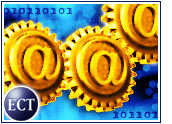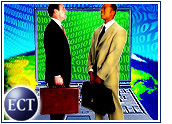
When it comes to buying and selling products, companies seem to have turned away from each other — and the bigger the companies are, the less they want to talk.
This decline in personal interaction during the sales process may be due partly to the rise of business-to-business, or B2B, exchanges. These automated online marketplaces have moved past early stumbles and now can help companies reach new levels of accuracy, efficiency and profitability. In fact, many large corporations have begun requiring their trading partners to conduct sales ordering, payment and fulfillment online or not at all.
However, although conducting B2B transactions online has become standard operating procedure, the way these exchanges are designed and run is anything but standardized. Companies can choose among a mind-boggling array of options, including buying a toolset and building the exchange in-house; purchasing off-the-shelf software; and extending their existing enterprise resource planning (ERP) setups.
Which option is best for a growing company?
Do-It-Yourself Dinosaur
For starters, one of the three paths to building a B2B exchange has nearly disappeared in recent years.
“Taking the traditional build approach has changed quite a bit from the 1998 and ’99 time frame, when companies used to go out and buy the tools and build it themselves,” Bob Werkema, product manager for IBM WebSphere Commerce, told the E-Commerce Times.
Although tools are available to let a company build a simple B2B touch point, he said, most firms will not find this approach to be efficient.
“If all you’re trying to do is take orders from 10 of your partners, maybe you could build that,” Werkema explained. “But as soon as you get into a contract-driven kind of environment, where each partner has its own way of wanting to do business with you, building a solution becomes incredibly complex.”
All But the Kitchen Sink
Right now, therefore, the two best options are purchasing packaged software and building out existing ERP implementations. Competition between vendors has been heating up, with SAP, Oracle and other ERP players taking on established exchange software and service giants, such as IBM, Transora, GlobalNetXchange and WorldWide Retail Exchange.
The ERP vendors tout the benefits of easy integration with their existing software.
“We help customers to really leverage the data and investments they’ve already made, rather than replicating solutions they already have in place,” Angela Bandlow, director of product marketing for mySAP customer relationship management, told the E-Commerce Times.
For example, Bandlow said, SAP’s e-commerce solution can link directly into its supply chain applications, enabling customers to access real-time inventory. Also, she noted that with SAP, all data resides in a single location. This centralized model prevents duplication of effort or miscommunication of information, which sometimes occurs when an e-commerce platform must communicate with various software programs across an enterprise.
Everything But Pandora
However, not all businesses are already ERP customers. Among non-customers, particularly small- and mid-size businesses, off-the-shelf software has become a popular choice for creating an e-commerce strategy that includes B2B, business-to-consumer (B2C) and marketing channel management capabilities, according to IBM’s Werkema.
In many ways, the decision about which route to choose boils down to price. For example, IBM offers a scaled-down version of its e-commerce software called WebSphere Commerce Express. At US$20,000 per processor, the software provides a great deal of functionality for a relatively low price, Werkema said.
Also, he added, off-the-shelf solutions provide more stable pricing than ERP packages, which often require extensive customization by expensive consultants.
“Once you go down [the ERP] path, it’s awfully hard to stop,” he said. “If you have to call a consultant to make changes to the software every time one of your business relationships changes, that can become a very painful thing.”
On the Exchange
However, regardless of which path companies choose, B2B exchanges are not entirely problem-free. While the front-end trading portion of such marketplaces has been refined over time, in many cases the back-end processes — ranging from handling purchase orders and credit references to billing and shipping — have not lived up to their potential.
“The place this has fallen woefully short is on the back end,” David Lonsdale, CEO of bTrade, confirmed in an interview with the E-Commerce Times. “This was a brand-new, very powerful technology, but it didn’t link to existing systems that customers were using. As a result, companies have been very disappointed.”
To remedy this deficit, bTrade partners with online exchanges, including Transora, GlobalNetXchange and WorldWide Retail Exchange, to provide back-end integration for online exchange relationships.
“If you look at the ’90s, it was the decade of efficiencies that were gained behind the firewall,” Lonsdale said. “In the 2000s, the efficiencies that are going to be gained are efficiencies outside the firewall, in [the] way that you and your business partners work together.”
Leaping the Pond
Another potential problem is that even as industry leaders aggressively sell their strong points, some industry veterans believe most of the value already has been wrung out of the B2B exchange equation.
“When the whole exchange and e-sourcing wave began, people were looking at 10 percent to 30 percent in savings by doing a piece of work more efficiently,” Dave Horne, CEO of XPORTA, told the E-Commerce Times. “By 2001 and 2002, they had already gotten all of the low-hanging fruit and were down to the 1 percent and 2 percent gains they could get out of the technology.”
This reduction in potential gains coincided with the trend toward U.S. companies searching overseas for low-cost materials, manufacturing services and manpower, Horne said. As a result, a new market has been created for e-commerce software suppliers that have seen their products become commodities that compete largely on price.
“I think the new technologies are going to be in the decision-support space or in [the] supplier discovery side” to help U.S. companies find overseas, low-cost trading partners, Horne said. “They can gain massive savings by going overseas, but there’s a real monkey wrench in figuring out how to accomplish this. Some of our old exchange technologies will morph themselves to meet these new requirements.”
















































i’m curious to see emarketer’s take – they have lots of great b2b data – i saw their analyst steven butler or whoever quoted a lot about it